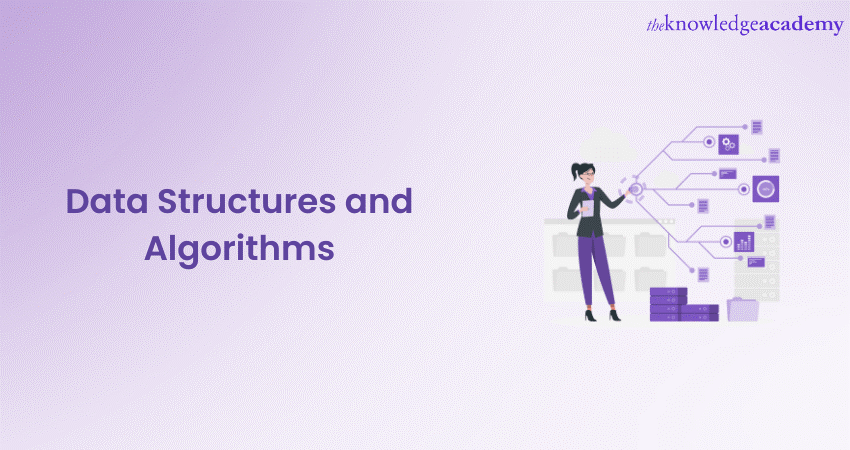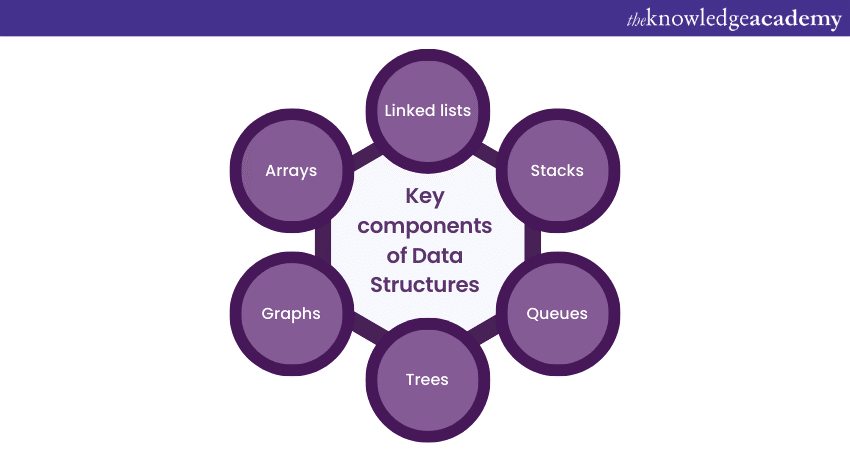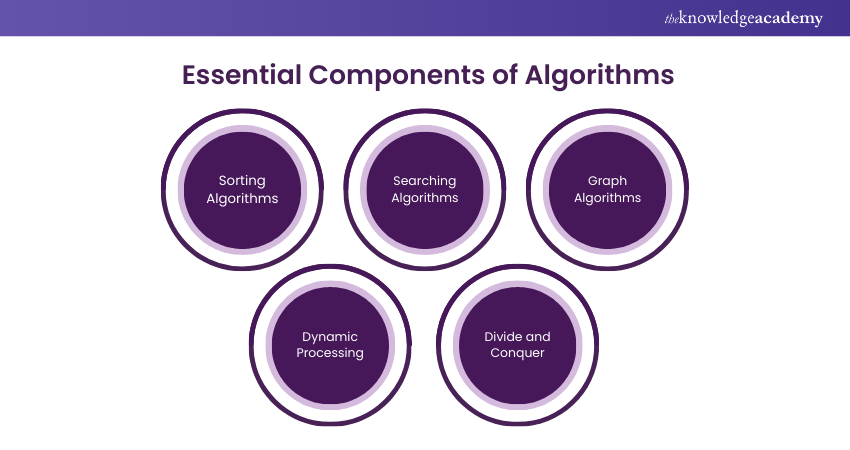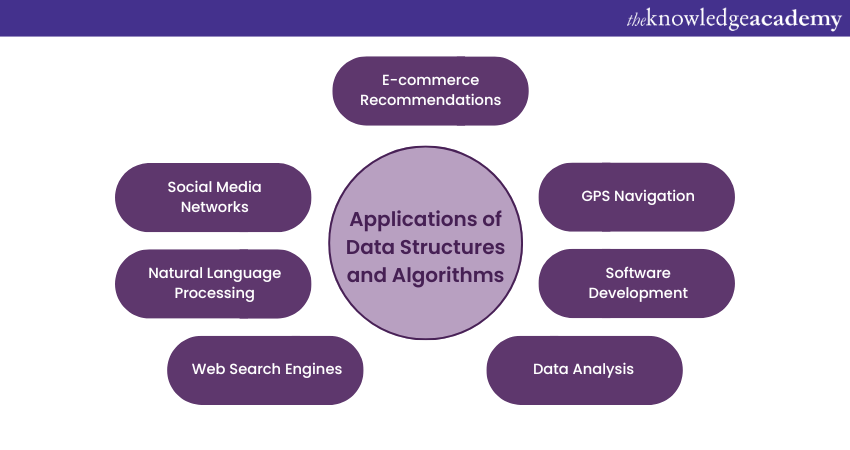We may not have the course you’re looking for. If you enquire or give us a call on +49 8000101090 and speak to our training experts, we may still be able to help with your training requirements.
Training Outcomes Within Your Budget!
We ensure quality, budget-alignment, and timely delivery by our expert instructors.

Data Structures and Algorithms are the pivotal steps that lead to grace and power in the world of computing. But why are these elements so crucial, and how do they interlock to elevate the art of coding? At its core, these foundational concepts form the bedrock upon which efficient and scalable software applications are built.
This comprehensive blog will escort you through the nuanced realms of Data Structures and Algorithms, shedding light on their interdependence and the transformative effect they exert on crafting cutting-edge software. Let’s read this blog to redefine our approach to programming.
Table of Contents
1) Understanding Data Structures and Algorithms
2) Key components of Data Structures
3) Key components of Algorithms
4) Real-world applications of Data Structures and Algorithms
5) Data Structures and Algorithms in Coding Interviews
6) Conclusion
Understanding Data Structures and Algorithms
Data Structures and Algorithms is a foundational concept in the Computer Science and Software Development domain. Let's break down what Algorithms and Data Structures entail:
Data Structures
Data Structures are the fundamental units that allow us to organise and store data efficiently. Think of them as containers that hold and manage information in a structured manner. Properly chosen Data Structures can significantly impact the efficiency and performance of an Algorithm. Let's explore an example of Data Structures:
|
# Creating an array my_array = [1, 2, 3, 4, 5] print(my_array[0]) # Output: 1 # Modifying elements my_array[2] = 10 print(my_array) # Output: [1, 2, 10, 4, 5] |
The above is an example of an array, which is a critical component in Data Structures. In that example, we've explored how to create it.
Unleash your coding potential with our Python Programming Training – Sign up now!
Algorithms
Algorithms, in contrast, are step-by-step instructions for solving a particular problem. They define the logic and operations required to manipulate and process data stored in Data Structures. Efficient Algorithms are vital for optimising resource usage and improving the execution time of programs. Let's explore an example of Algorithm:
|
def bubble_sort(arr): n = len(arr) for i in range(n): for j in range(0, n - i - 1): if arr[j] > arr[j + 1]: arr[j], arr[j + 1] = arr[j + 1], arr[j]
# Example usage arr = [64, 34, 25, 12, 22, 11, 90] bubble_sort(arr) print("Sorted array:", arr) |
The above is an example of a Bubble sort Algorithm. Bubble sort is an effortless sorting Algorithm that repeatedly steps through the list. It differentiates adjacent elements and swaps them if they are in the wrong order.
The Relationship Between Data Structures and Algorithms
Understanding the collaboration between Data Structures and Algorithms is key to designing robust and efficient software solutions. Let’s talk about this in detail:
1) Reciprocal Impact: The interplay between Data Structures and Algorithms is critical; the choice of one can greatly affect the performance of the other.
2) Enhancing Efficiency: The strategic selection of Data Structures can significantly improve the efficiency of Algorithms. Utilising a hash table, for example, can accelerate search processes and increase the speed of search Algorithms.
3) Essential for Problem-Solving: Proficiency in both Data Structures and Algorithms is vital for solving complex problems in Computer Science, as they provide the foundation for creating effective and efficient solutions.
4) Optimisation of Algorithms: The relationship between Data Structures and Algorithms allows for the optimisation of Algorithms through the careful selection of the most suitable Data Structures, enhancing performance and conserving resources.
5) Synergistic Role: Data Structures are the backbone for organising and storing data, while Algorithms are the strategies used for processing this data effectively, demonstrating their combined role in software development.
Shape your software skills with our Object-Oriented Fundamentals Training – sign up today!
Key components of Data Structures
Data Structures form the fundamentals of Computer Science, serving as the essential containers for organising and storing data. Here are some of the key Data Structures frequently used in various programming and Algorithmic tasks:

1) Arrays: An array is a sequential Data Structure that holds a set of items sharing the same type. It ensures that elements are stored in adjacent memory locations, which facilitates access in constant time due to each element’s distinct index.
2) Linked lists: It is a sequential Data Structure that organises information into individual elements known as nodes. Each node contains data and a pointer that links to the next node, creating a chain. Distinct from arrays, linked lists do not require consecutive memory spaces, offering greater flexibility in memory allocation.
3) Stacks: A stack is a structured data model that adheres to a specific sequence for executing operations. This sequence is typically characterised as LIFO (Last In, First Out), meaning the most recently added element is the first to be removed. Alternatively, it can be described as FILO (First In, Last Out), where the initial element added is the last to be retrieved. Essentially, LIFO denotes that the last element to enter is the first to exit, while FILO indicates the first element to enter is the last to exit.
4) Queues: A queue is another linear Data Structure that follows the First-In-First-Out (FIFO) principle. It is used for tasks like scheduling, managing resources, and modelling real-world scenarios where entities are processed in the order they arrive.
5) Trees: These are hierarchical Data Structures with root nodes and child nodes. They have applications in organising data hierarchically and are used for tasks like searching and hierarchical data representation. Common types of trees include binary trees, binary search trees, and Adelson-Velsky and Landis (AVL) trees.
6) Graphs: Graphs are versatile Data Structures used to model relationships between entities. They consist of nodes (vertices) and edges (connections), making them suitable for applications like social networks, route finding, and network modelling. Graphs come in various forms, including directed and undirected graphs.
Such Data Structures serve as the building blocks for solving a wide range of problems in Computer Science and Software Development. Each has its strengths and weaknesses, and the choice of the right Data Structure depends on the specific requirements of a given task. Understanding how to select and use these Data Structures effectively is a crucial skill for any Programmer or Computer Scientist.
Key Components of Algorithms
Algorithms are the engines that drive the manipulation and processing of data in these Data Structures. Here are some essential Algorithms to be aware of:

1) Sorting Algorithms: Sorting Algorithms arrange elements in a specified order, be it ascending or descending. Common sorting Algorithms include Bubble Sort, Merge Sort, Quick Sort, and more.
2) Searching Algorithms: Searching Algorithms are used to find a specific element in a dataset. Binary search and linear search are widely used search techniques.
3) Graph Algorithms: Graph Algorithms, such as Dijkstra's Algorithm and breadth-first search, are used to solve problems related to networks, routing, and traversal.
4) Dynamic Programming: Dynamic Programming is a strategy used to solve complex problems by breaking them into smaller, overlapping subproblems. It's commonly used for optimisation problems, such as the Fibonacci sequence or the Knapsack problem.
5) Divide and Conquer: The divide-and-conquer approach tactic includes dividing an issue into smaller subproblems and solving them independently. Algorithms like the Fast Fourier Transform (FFT) and the merge step in merge sort follow this paradigm.
Elevate your coding skills with our comprehensive Ruby Programming Course – register now and start building amazing applications!
Real-world Applications of Data Structures and Algorithms
In order to grasp the practical significance of Data Structure and Algorithms, let's explore their role in a few real-world projects:

1) Web Search Engines: Search engines like Google use complex Data Structure and Algorithms to retrieve relevant results quickly. Web pages are indexed using Data Structures like inverted indexes, and searching is made efficient using Algorithms like PageRank.
2) Natural Language Processing (NLP): NLP Techniques like Language translation, sentiment analysis, and chatbots use Algorithms to process and understand human language, enabling communication and automation.
3) Social Media Networks: Social networks like Facebook employ Algorithms to recommend friends, content, and ads. Graph Algorithms are crucial for establishing connections and relationships between users.
4) E-commerce Recommendations: E-commerce platforms like Amazon rely on recommendation systems that use collaborative filtering Algorithms to recommend products to users, as per their past behaviour and preferences.
5) GPS Navigation: Navigation apps like Google Maps use graph Algorithms to find the shortest and fastest routes between locations. Data Structures like maps and spatial indexes facilitate efficient map retrieval.
6) Software Development: Data Structures and Algorithms are fundamental in Software Development. They are used to design efficient data storage solutions, improve program performance, and ensure that applications can scale to tackle large amounts of data.
Data Analysis: In Data Science and Analytics, Algorithms are used to process, analyse, and derive insights from vast datasets. Data Structures like trees and hash tables are employed for efficient data storage and retrieval.
Become a pro with our step-by-step Programming Training – book your spot now and master the coding art!
Data Structures and Algorithms in Coding Interviews
The importance of Data Structures and Algorithms goes beyond just project development. They are also extremely crucial in coding interviews. Tech companies often assess candidates' problem-solving skills through Algorithmic questions. Here are some tips for mastering Algorithms and Data Structures in coding interviews:
Start With the Basics: Start your learning journey by gaining a fundamental understanding of Data Structure and Algorithms. This involves comprehending their significance and diving into essential topics to build a strong foundation.
Choose a Programming Language: There are multiple programming languages available right now. So, select one from the List of Programming Languages that you are comfortable with or interested in. You'll need this language to implement and experiment with DSA.
Practice Consistently: Actively practice what you learn on Algorithms and Data Structures. Work on problems and coding challenges related to the Data Structures and Algorithms you're studying. Practice is essential to reinforce your understanding.
Understand Time and Space Complexity: Learn how to analyse the time and space complexity of Algorithms. This skill will help you assess the efficiency of your code and make informed design choices.
Online Resources and Courses: Utilise online resources, courses, and communities dedicated to DSA. These can provide structured learning and support, making your journey more efficient.
Remember that learning DSA is a gradual process. It's okay to start with the basics and progressively work your way up to more advanced topics. Patience, practice, and persistence are key to mastering these fundamental concepts in Computer Science.
Conclusion
We hope you read and understand Data Structures and Algorithms. They form the backbone of programming and Computer Science, enabling efficient problem-solving. These skills are indispensable for tech professionals. By continuous learning, you can hone your expertise, navigate the ever-evolving tech landscape and stay at the forefront of innovation.
Future-proof your career with our D Programming Language Training – join us and begin your journey to success!
Frequently Asked Questions

Common mistakes include not practising enough, focusing only on theory without coding, neglecting Algorithm analysis, and failing to understand the underlying concepts. It's crucial to solve diverse problems, write efficient code, and review foundational principles regularly.

Advanced Data Structures include balanced trees (AVL, Red Black), B-trees, tries, segment trees, suffix trees, and Fibonacci heaps. These structures optimise complex operations like searching, sorting, and dynamic updates, which are essential for high-performance computing tasks.

The Knowledge Academy takes global learning to new heights, offering over 30,000 online courses across 490+ locations in 220 countries. This expansive reach ensures accessibility and convenience for learners worldwide.
Alongside our diverse Online Course Catalogue, encompassing 17 major categories, we go the extra mile by providing a plethora of free educational Online Resources like News updates, Blogs, videos, webinars, and interview questions. Tailoring learning experiences further, professionals can maximise value with customisable Course Bundles of TKA.

The Knowledge Academy’s Knowledge Pass, a prepaid voucher, adds another layer of flexibility, allowing course bookings over a 12-month period. Join us on a journey where education knows no bounds.

The Knowledge Academy offers various Programming Trainings, including the Data Structure and Algorithm Training, R Programming Course, and Bootstrap Training. These courses cater to different skill levels, providing comprehensive insights into What is Programming.
Our Programming & DevOps Blogs cover a range of topics related to Data Structures and Algorithms, offering valuable resources, best practices, and industry insights. Whether you are a beginner or looking to advance your Programming skills, The Knowledge Academy's diverse courses and informative blogs have got you covered.
Upcoming Programming & DevOps Resources Batches & Dates
Date
 Data Structure and Algorithm Training
Data Structure and Algorithm Training
Fri 17th Jan 2025
Fri 21st Mar 2025
Fri 16th May 2025
Fri 18th Jul 2025
Fri 19th Sep 2025
Fri 21st Nov 2025







 Top Rated Course
Top Rated Course


 If you wish to make any changes to your course, please
If you wish to make any changes to your course, please


